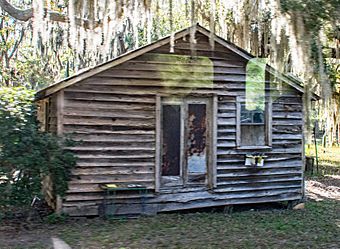Hog Hammock, Georgia facts for kids
Quick facts for kids |
|
|
Hogg Hummock Historic District
|
|

A historic structure in Hog Hammock
|
|
| Location | E side of Sapelo Island, Hog Hammock, Georgia |
|---|---|
| Area | 427 acres (173 ha) |
| Built | 1878 |
| NRHP reference No. | 96000917 |
| Added to NRHP | September 6, 1996 |
Hog Hammock is a unique African-American community found on Sapelo Island. This island is a natural barrier island located off the coast of Georgia, USA. It's about 45 miles (72 km) south of Savannah, near the port of Darien, Georgia.
The entire community, which covers about 427 acres (173 hectares), was officially recognized as the Hog Hammock Historic District in 1996. This means it's a place with important historical buildings and sites. Many of the homes here are simple, one-story buildings, often covered with wood siding.
Contents
Who Lives in Hog Hammock?
Many people who live full-time in Hog Hammock are African Americans known as Gullah-Geechees. These residents are descendants of West African people who were brought to the island as enslaved people in the 1700s and 1800s. They worked on the island's large farms, called plantations. In 2009, there were about 47 Gullah-Geechee residents living in the community year-round.
Community Life and Services
Hog Hammock is a lively community with homes, a general store, and even a public library. There are also small businesses, including places where visitors can stay for vacation.
Churches and Faith
The community has two active churches. St. Luke Baptist Church was started in 1885. First African Baptist Church was established even earlier, in 1866. The First African Baptist Church also has an older building. It was built in 1900 in a nearby area called Raccoon Bluff. This older church is still used for special events and services.
The Hog Hammock Public Library
The Hog Hammock Public Library is an important part of the community. It was first started in 2002 by a group called SICARS. By 2006, the library became its own organization. It joined the Three Rivers Regional Library System, which is based in Jesup, Georgia. The library is located in what used to be a two-room schoolhouse. It has over 2,500 items, including a special collection about Sapelo Island's history.
Daily Life and School
Life in Hog Hammock is a bit different from the mainland. Residents need to bring most of their supplies from the mainland. They can also buy some things at the small island store. Children living in Hog Hammock take a ferry boat to the mainland every day. From there, they ride a bus to school. The island's own school closed down in 1978.
Preserving Hog Hammock's History
The Sapelo Island Cultural and Revitalization Society, Inc. (SICARS) is a non-profit group. Their main goal is to protect and improve the Hogg Hummock Community. SICARS was founded in 1993 by people who live on Sapelo Island and descendants who live elsewhere.
SICARS' Mission
The people who started SICARS wanted to help their community's future. They aimed to teach all visitors about the island's history. They also wanted to make sure everyone knew that Sapelo has been an African community for over 200 years. SICARS officially became an organization in 1994. Every year, on the third Saturday in October, SICARS hosts a fun Cultural Day festival.
Challenges and Changes
Over the years, Hog Hammock has faced some challenges. In the 1990s, people from the mainland started buying land from the Gullah residents. They built vacation homes on these properties.
Property Taxes and Zoning
In 2012, property tax officials told Hog Hammock residents that their property taxes would increase a lot. This happened even though the island school had been closed for many years. For example, one property owner's yearly tax bill jumped from $600 to $2,100.
By 2013, residents were actively fighting these sudden tax increases. Some worried they would be forced to leave the land their families had owned for many generations. They felt these changes would benefit mainlanders who wanted to buy more homes in Hog Hammock.
In 2022, the county reached an agreement to resolve the issue. This agreement froze some residents' property taxes until 2025. The county also agreed to improve emergency services and road maintenance on the island.
However, in September 2023, the McIntosh County commission voted to change zoning rules. This vote, which was 3 to 2, allowed homes in Hog Hammock to be more than twice as large as before. The commission chair mentioned that the island's culture was changing because some Gullah residents had sold their land.



